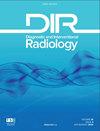"Rings of Saturn" appearance: a unique finding in a case of COVID-19 pneumonitis.
IF 1.7
4区 医学
Q2 Medicine
引用次数: 11
Abstract
Since March 2019 when the severe respiratory syndrome of coronavirus disease 2019 (COVID-19) was announced, many radiologic manifestations of COVID-19 have been reported (1). Bilateral ground glass opacities (GGOs) predominantly at lower and posterior segments, mixed pattern of GGOs and consolidation and septal thickening are the most common features. Halo sign, nodular pattern, pleural effusion, and even completely normal findings are less frequently reported. We have encountered a unique CT appearance of COVID-19 pneumonitis in a 24-year-old man. This finding is not a halo or reverse halo sign as might be expected in these organizing pneumonias. Figure demonstrates focal core opacity and two ring-like opacities immediately around it as in the “rings of Saturn”. From a pathologic perspective, initially the virus enters the alveoli, followed by viral proliferation and local and generalized immune system response with cytokine storm by immunological modulators. This is most commonly followed by a recovery phase with pulmonary parenchymal tissue repair processes (2). CT may initially demonstrate localized GGOs, followed by more widespread GGOs, typically combined with consolidation, crazy paving, and the formation of fibrotic strips (3, 4). Concurrent invasion and resolving phases are due to immunity response in multiple phases as seen in organizing pneumonia. The most prominent differences between organizing pneumonia and resolving focal GGOs of COVID-19 include faster and less severe local reaction, with faster recovery and less fibrotic changes of simple resolving GGOs. Focal necrosis with surrounding hemorrhage is the main pathology of the halo sign typical of organizing pneumonia, which is not expected in COVID-19. The pathological distribution of organizing pneumonia is in both alveoli and terminal bronchioles. Bronchiolar involvement can be due to thick alveolar exudates and inflammatory bronchial wall thickening. Similarly, our presented feature appears to be due to bronchiole interstitial spreading and vascular impairment as a part of the cytokine storm with interstitial pneumonitis and focal organizing pneumonia with step-by-step veno-lymphatic spreading. This is the first report of this particular finding and needs to be supported by additional observations and studies.“土星环”外观:COVID-19肺炎病例的独特发现。
本文章由计算机程序翻译,如有差异,请以英文原文为准。
求助全文
约1分钟内获得全文
求助全文
来源期刊
CiteScore
3.50
自引率
4.80%
发文量
69
审稿时长
6-12 weeks
期刊介绍:
Diagnostic and Interventional Radiology (Diagn Interv Radiol) is the open access, online-only official publication of Turkish Society of Radiology. It is published bimonthly and the journal’s publication language is English.
The journal is a medium for original articles, reviews, pictorial essays, technical notes related to all fields of diagnostic and interventional radiology.

 求助内容:
求助内容: 应助结果提醒方式:
应助结果提醒方式:


